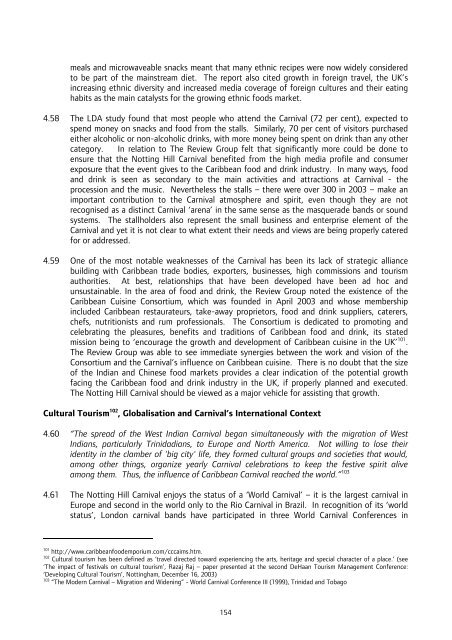Notting Hill Carnival Strategic Review - Intelligent Space
Notting Hill Carnival Strategic Review - Intelligent Space
Notting Hill Carnival Strategic Review - Intelligent Space
Create successful ePaper yourself
Turn your PDF publications into a flip-book with our unique Google optimized e-Paper software.
meals and microwaveable snacks meant that many ethnic recipes were now widely considered<br />
to be part of the mainstream diet. The report also cited growth in foreign travel, the UK’s<br />
increasing ethnic diversity and increased media coverage of foreign cultures and their eating<br />
habits as the main catalysts for the growing ethnic foods market.<br />
4.58 The LDA study found that most people who attend the <strong>Carnival</strong> (72 per cent), expected to<br />
spend money on snacks and food from the stalls. Similarly, 70 per cent of visitors purchased<br />
either alcoholic or non-alcoholic drinks, with more money being spent on drink than any other<br />
category. In relation to The <strong>Review</strong> Group felt that significantly more could be done to<br />
ensure that the <strong>Notting</strong> <strong>Hill</strong> <strong>Carnival</strong> benefited from the high media profile and consumer<br />
exposure that the event gives to the Caribbean food and drink industry. In many ways, food<br />
and drink is seen as secondary to the main activities and attractions at <strong>Carnival</strong> - the<br />
procession and the music. Nevertheless the stalls – there were over 300 in 2003 – make an<br />
important contribution to the <strong>Carnival</strong> atmosphere and spirit, even though they are not<br />
recognised as a distinct <strong>Carnival</strong> ‘arena’ in the same sense as the masquerade bands or sound<br />
systems. The stallholders also represent the small business and enterprise element of the<br />
<strong>Carnival</strong> and yet it is not clear to what extent their needs and views are being properly catered<br />
for or addressed.<br />
4.59 One of the most notable weaknesses of the <strong>Carnival</strong> has been its lack of strategic alliance<br />
building with Caribbean trade bodies, exporters, businesses, high commissions and tourism<br />
authorities. At best, relationships that have been developed have been ad hoc and<br />
unsustainable. In the area of food and drink, the <strong>Review</strong> Group noted the existence of the<br />
Caribbean Cuisine Consortium, which was founded in April 2003 and whose membership<br />
included Caribbean restaurateurs, take-away proprietors, food and drink suppliers, caterers,<br />
chefs, nutritionists and rum professionals. The Consortium is dedicated to promoting and<br />
celebrating the pleasures, benefits and traditions of Caribbean food and drink, its stated<br />
mission being to ‘encourage the growth and development of Caribbean cuisine in the UK’ 101 .<br />
The <strong>Review</strong> Group was able to see immediate synergies between the work and vision of the<br />
Consortium and the <strong>Carnival</strong>’s influence on Caribbean cuisine. There is no doubt that the size<br />
of the Indian and Chinese food markets provides a clear indication of the potential growth<br />
facing the Caribbean food and drink industry in the UK, if properly planned and executed.<br />
The <strong>Notting</strong> <strong>Hill</strong> <strong>Carnival</strong> should be viewed as a major vehicle for assisting that growth.<br />
Cultural Tourism 102 , Globalisation and <strong>Carnival</strong>’s International Context<br />
4.60 “The spread of the West Indian <strong>Carnival</strong> began simultaneously with the migration of West<br />
Indians, particularly Trinidadians, to Europe and North America. Not willing to lose their<br />
identity in the clamber of 'big city' life, they formed cultural groups and societies that would,<br />
among other things, organize yearly <strong>Carnival</strong> celebrations to keep the festive spirit alive<br />
among them. Thus, the influence of Caribbean <strong>Carnival</strong> reached the world.” 103<br />
4.61 The <strong>Notting</strong> <strong>Hill</strong> <strong>Carnival</strong> enjoys the status of a ‘World <strong>Carnival</strong>’ – it is the largest carnival in<br />
Europe and second in the world only to the Rio <strong>Carnival</strong> in Brazil. In recognition of its ‘world<br />
status’, London carnival bands have participated in three World <strong>Carnival</strong> Conferences in<br />
101<br />
http://www.caribbeanfoodemporium.com/cccaims.htm.<br />
102<br />
Cultural tourism has been defined as ‘travel directed toward experiencing the arts, heritage and special character of a place.’ (see<br />
‘The impact of festivals on cultural tourism’, Razaj Raj – paper presented at the second DeHaan Tourism Management Conference:<br />
‘Developing Cultural Tourism’, <strong>Notting</strong>ham, December 16, 2003)<br />
103<br />
“The Modern <strong>Carnival</strong> – Migration and Widening” - World <strong>Carnival</strong> Conference III (1999), Trinidad and Tobago<br />
154








